
© Railway Wonders of the World 2012-


The State Lines of Latvia
Growth of a Modern European System
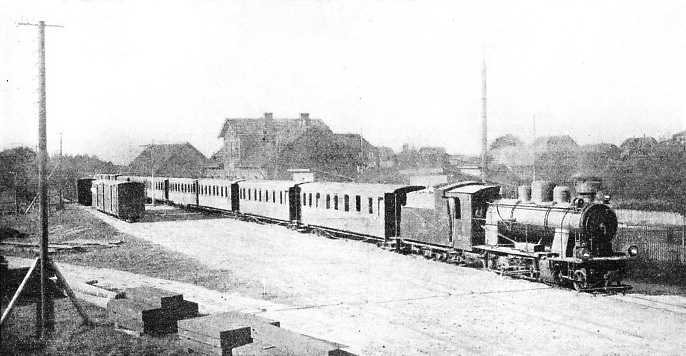
A WOOD-
THE railways of the republic of Latvia are an interesting example of the changes brought about in Europe since the war of 1914-
With five different gauges and the unusual mixture of rolling-
When the Republic of Latvia was proclaimed on November 18, 1918, it was more of a hope than a reality. The Lettish people have occupied the country since the earliest times. In the 12th century the country was invaded by the Teutonic Knights, and centuries of subjection followed during the stormy history of this part of the Baltic. From 1795 until 1918 the country was subject to Russia, the area being divided between the Baltic provinces of Livonia in the north and Courland in the south. For about two years the people waged a war of independence against the Russians, and also against German adventurers, and when, in 1920, they were at last at peace, the land was in a terrible plight. It had been a battlefield during the world war, when the Letts fought as members of the Russian army, and again a battlefield when they were struggling to free their country from invaders who had come pouring in from east and west. When the Germans invaded the country during the war of 1914-
As a means of transport the railways were negligible when the country emerged from the ordeal by battle. Under the Peace Treaty of 1920 the Latvian Government received from Russia and from Germany 305 locomotives and 2,274 carriages and wagons. Few of these were in good order, and much repair work had to be done. The railway workshops were in a bad plight; most of the stations had been burnt down, plant and machinery had been plundered and scattered, and many bridges had been destroyed. In fact, Riga and the other industrial centre of Liepaja (then known as Libau) were little more than empty shells.
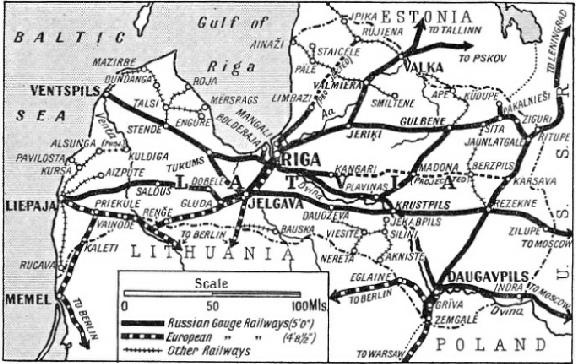
LATVIA’S MAIN LINES are shown on this map. There are about 1,925 miles of track in existence, and the country's five gauges vary from 2 ft to 5 ft. All lines, except 110 miles privately owned, are State controlled. Over half the mileage is of the 5 ft Russian gauge.
When Latvia began the tremendous task of rebuilding her railways five big bridges had to be built across the River Daugava (Dvina), the most important liver in the country, and two other large bridges across the rivers Lielupe and Gauja. In addition, there were no fewer than 400 smaller bridges to be reconstructed. Besides all this work, 1,500 station buildings had to be erected.
Railway workshops in Riga, Daugavpils (formerly Dvinsk) and Liepaja were restored, and about 250 miles of new track built. Some 235 locomotives and 5,000 carriages and wagons were either repaired or built, and the whole railway system made efficient. At present there are 304 locomotives and 6,700 carriages and wagons on the Latvian State lines.
The problem was to build a country as well as to reconstruct its railways. One of the first steps was to create a nation of small-
Another factor was the changed economic situation. Before the war Riga was an outlet for Russian produce, which was brought to the port by rail, but after the war this traffic practically ceased to exist, although it revived later. Further, the railways had been built as part of the Russian system to serve the needs of that country, and adjustments were necessary to make them serve the needs of Latvia.
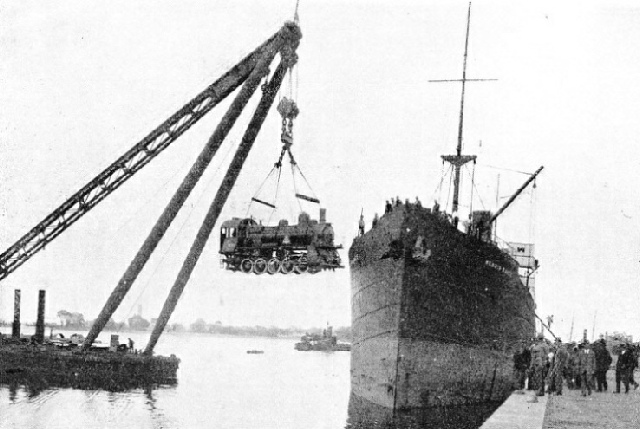
AT RIGA.
A large locomotive being unloaded at the docks for transportation to Russia. Riga is the railway centre of Latvia, and most of the main routes radiate from the capital.
Its position makes Riga the natural capital, and it is not only a great port but also the focal point of the railway system. Only a few new links were needed to form a good network of lines for the new country. In addition to Riga there are excellent harbours at Liepaja and at Ventspils (formerly Windau), both of which are west of Riga and are on the Baltic. Riga lies a few miles from the mouth of the River Daugava, which flows from Russia and is used for floating rafts of logs which are cut up at sawmills at the port. Some of this timber comes from. Russia and Poland, but the bulk is from Latvia.
As the country is flat and low-
When the Germans invaded Latvia they altered the track to standard gauge, as they had done for military purposes in Lithuania and in Poland. Riga being the natural outlet for Russian trade, the Letts restored the Russian gauge on the principal lines leading to and from Russia. Some of the lines leading south from certain towns and connecting with Lithuania and Poland were, as explained later, left on the standard gauge.
An important line on the Russian gauge leaves Riga and follows the valley of the Daugava to Indra, 178 miles from Riga, where it crosses the Russian border for Moscow. Soon after leaving Riga this line throws off a branch to the cast to Kangari, the branch being part of a line now under construction which will intersect another line at Madona, a narrow gauge line at Berzpils, and link up with a broad gauge line at Karsava. The main line proceeds to Plavinas, from which town a line runs north-
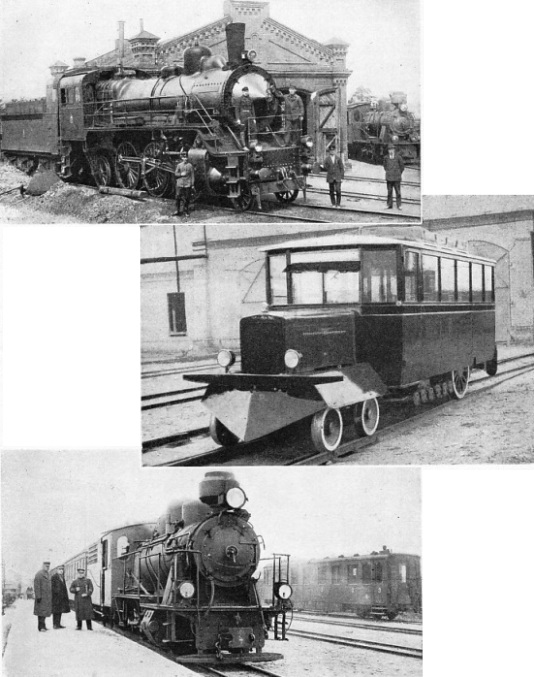 A RUSSIAN GAUGE LOCOMOTIVE which has the 2-
A RUSSIAN GAUGE LOCOMOTIVE which has the 2-
RECENT RAILWAY DEVELOPMENTS such as the rail-
A 2 ft 5½-
Daugavpils is also an important junction. The broad-
From Zemgale a 5 ft track, running beside the standard gauge line, leads up through Daugavpils, Rezekne, Karsava and Jaunlatgale to Ritupe, on the Russian border, which it crosses on its way to Leningrad. In the old days this was the main line from St. Petersburg (now Leningrad) to Warsaw. The part of the line in Poland has now been relaid to standard gauge. The traffic to-
Liepaja is the most important city and port after Riga, and has an advantage over Riga because its harbour is not ice-
There still remained the necessity of ensuring through transit for goods between Russia and the ice-
Four Gauges in One Town
There are two stations with a road between them at Riga -
Riga has only two gauges, but lines of four gauges run into Liepaja. In addition to the broad and standard gauge lines just mentioned, a metre gauge track runs up to Aizpute, while a 75 cm track goes south to Rucava parallel with the coast, and north along the coast to Pavilosta, just beyond Kursa, which is a junction for a branch of this line, which goes to Alsunga and is being extended to the town of Kuldiga. A busy line runs from Riga to Ventspils, the third most important port. This line throws off a branch to Bolderaja on the shore of the Gulf of Riga, and serves seaside resorts. Tukums is the junction for a line to Jelgava, and the line proceeds through Stende to Ventspils. From Stende and Ventspils 2 ft gauge lines serve the country between the track and the shore of the Gulf of Riga and the Baltic.
A line runs north-
Lines of 75 cm gauge traverse the country between the east shore of the Gulf of Riga and the northern section of the Riga-
The principal traffic is composed of timber, flax being the next most important item. The transit trade between the ports and Russia is reviving.
At one time nearly all the locomotives burnt wood, but in recent years it has been found more economical to export timber than to burn it, so that coal -
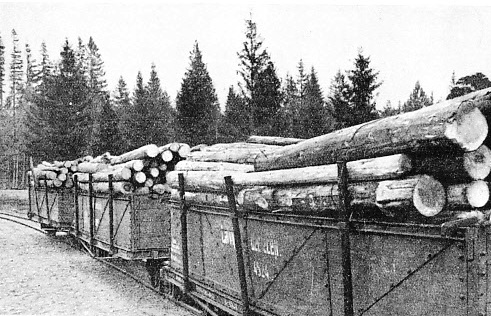
ON A NARROW-
There are sleeping and restaurant cars on the main transit routes, while the holiday traffic to what is called the “Baltic Riviera” in the summer is brisk. Although the country is off the track of the tourist, the Ministry of Communications, which operates the railways, is enterprising and provides such innovations as cars in which passengers may dance. Various excursions attract holiday makers. One innovation, which should appeal to passengers who find difficulty in deciding where to go for a day’s excursion, is the mystery train. (The idea is not unknown in Great Britain.) The mystery train in Latvia has an engine at either end, facing outwards, so that the passengers are unable to decide which way it is going when they board it at the station. The destination is not revealed to the excursionists until the train arrives there.
Another feature of the railways is that a tax of three per cent is put on railway tickets to provide a “culture fund”, allocated to a tourist bureau, clubs and various other purposes.
An unusual development is that of a medical department of the railways. The whole system, including offices and the houses of employees, is divided into fifteen districts, each of which is supervised by a physician. The physician is responsible for the health of his district; he attends all railway employees living or working there and their families. He has to render first aid, and in the event of an accident organizes the succouring of the injured persons.
Railway ambulances are kept at the principal centres and workshops. In Riga there is a hospital with fifty beds, an operating theatre and a laboratory. There is also a Central Railway Pharmacy, which supervises a number of subordinate pharmacies along the line.
There are about 200 persons on the medical staff, and the general supervision and control is in the hands of the Chief Physician, who, in turn, is himself responsible to the Chief Director of the Latvian State Railway system. The Railway Employees’ Association co-
Although at first the number of different gauges and the variety of rolling-
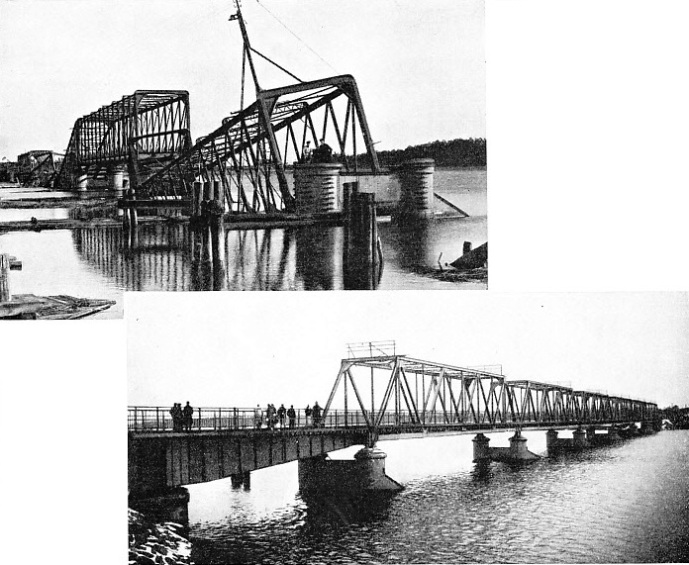
RECONSTRUCTION has been the main feature of the Latvian system. The top picture shows a wrecked railway bridge in 1919 across the Lielupe near Riga. There were many such scenes in Latvia after the Great War. The lower photograph shows the rebuilt bridge that carries the main line between Riga and Ventspils.
As Latvia is developing on the lines of a country of small-
Although Latvia is an agricultural country, the artisans and engineers are noted for their skill. In the old days more than a quarter of the metal industry of the former Russian Empire was concentrated in Riga and Liepaja, or Libau as it was then called, and to-
You can read more on “Estonia and Lithuania”, “Poland’s Main Lines” and “Russia and Siberia” on this website.